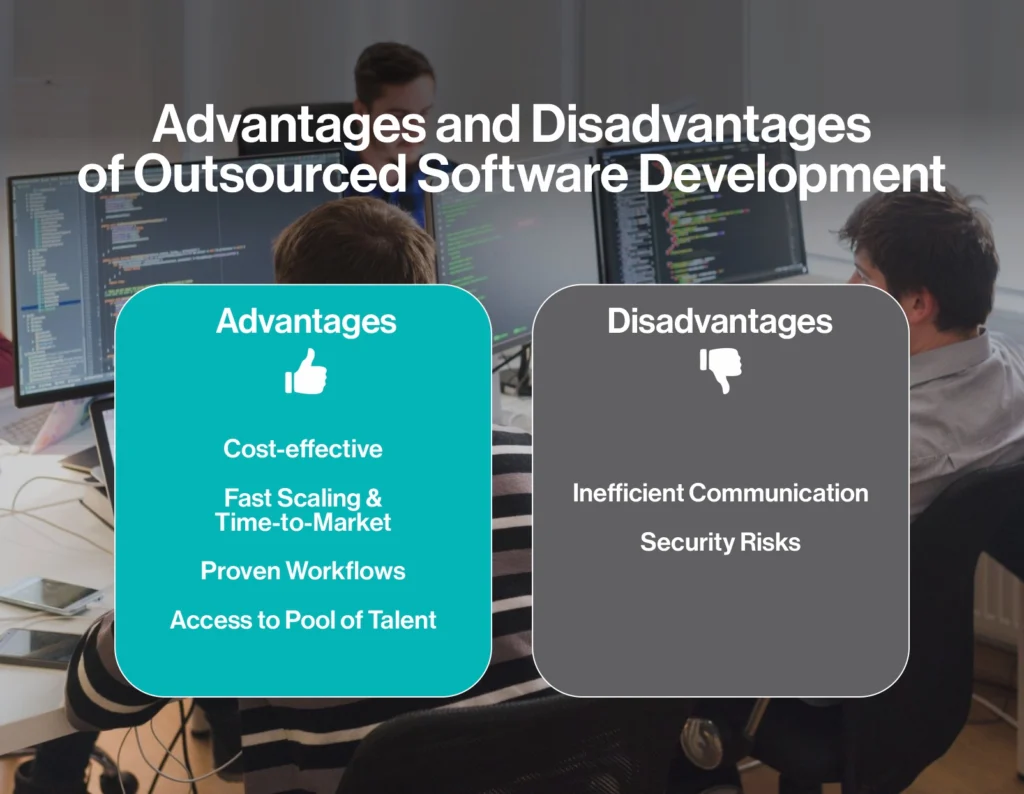Advantages and Disadvantages of Outsourcing Software Development
In today’s digital landscape, businesses rely on software development to…
In today’s digital landscape, businesses rely on software development to boost efficiency, enhance customer experience, and scale. While an in-house team ensures control, it can be costly and hard to keep up with tech advances. Outsourcing offers flexibility, cost savings, and access to global talent but may pose challenges in communication, quality control, and security.
One of the most significant benefits of outsourcing software development is cost savings. Companies can reduce expenses related to hiring, training, infrastructure, and operational costs. Many outsourcing firms operate in regions with lower labor costs, allowing businesses to achieve high-quality results at a fraction of the cost.
Outsourcing allows companies to tap into a vast pool of skilled developers, designers, and engineers from around the world. This ensures access to top-tier expertise in various programming languages, frameworks, and technologies without the constraints of local talent shortages.
Dedicated outsourcing teams can work around the clock, significantly reducing development time. By leveraging external expertise, businesses can accelerate project completion, meet tight deadlines, and gain a competitive edge in the market.
By outsourcing software development, companies can concentrate on their core competencies, such as sales, marketing, and customer service. This allows internal teams to focus on strategic initiatives while external experts handle technical tasks.
Outsourcing provides the flexibility to scale development teams up or down based on project needs. Businesses can easily adjust resources without the long-term commitments and overhead costs associated with hiring in-house developers.
Outsourcing partners often stay updated with the latest software development trends, tools, and best practices. This enables businesses to leverage cutting-edge technologies such as AI, blockchain, cloud computing, and cybersecurity without investing heavily in research and training.
Experienced outsourcing providers have established workflows, quality assurance processes, and risk management strategies. By partnering with a reliable outsourcing firm, businesses can minimize project risks, avoid common pitfalls, and ensure smooth execution.

Time zone differences, language barriers, and cultural differences can lead to communication gaps, misunderstandings, and delays. Companies must establish clear communication protocols, use collaboration tools, and conduct regular meetings to bridge these gaps.
Outsourcing involves sharing sensitive business data with third-party vendors, increasing the risk of data breaches and intellectual property theft. It is crucial to select a trusted outsourcing partner with strong security protocols, compliance certifications, and confidentiality agreements.
Ensuring high-quality deliverables can be challenging when working with external teams. Differences in coding standards, documentation, and testing procedures may impact the final product. Implementing rigorous quality assurance measures and conducting regular performance reviews can help maintain standards.
Over-reliance on an outsourcing partner can create long-term dependency, making it difficult to switch providers or bring development in-house. To mitigate this risk, businesses should maintain internal documentation, retain key knowledge, and ensure contractual flexibility.
While outsourcing is generally cost-effective, unforeseen expenses such as contract renegotiations, additional revisions, and project scope changes can arise. Transparent pricing models, well-defined contracts, and contingency planning can help manage costs effectively.
External developers may not fully grasp the company’s business goals, industry nuances, or customer expectations. Close collaboration, detailed project briefs, and continuous feedback loops are essential to align development efforts with business objectives.
Outsourcing software development across different countries can raise legal and regulatory concerns, especially regarding data protection laws such as GDPR, HIPAA, or PCI-DSS. Companies must ensure that their outsourcing partner complies with relevant regulations to avoid legal complications.
✅ Expert Partner: Proven track record with trusted client success stories.
✅ Clear Requirements: Defined goals, milestones, and deliverables.
✅ Strong Security: NDAs, audits, and strict data protection.
✅ Seamless Collaboration: Jira, Trello, Slack for smooth tracking.
✅ Regular Updates: Frequent reports and video calls.
✅ Risk-Free Start: Pilot project before scaling up.
Start outsourcing with confidence! 🚀
Outsourcing software development presents both opportunities and challenges. While it offers cost savings, access to global talent, and faster project delivery, businesses must also address potential risks such as communication barriers, security concerns, and quality control issues. By carefully selecting an outsourcing partner, implementing best practices, and maintaining open collaboration, companies can maximize the benefits of outsourcing while mitigating its drawbacks.
Ultimately, outsourcing is a strategic decision that, when executed correctly, can drive innovation, efficiency, and growth in an increasingly competitive digital landscape.

In today’s digital landscape, businesses rely on software development to…
Vietnam’s economy is growing steadily, attracting both locals and expatriates.…
Outsourcing and contracting are both common business strategies used to…
© 2023 STARACK